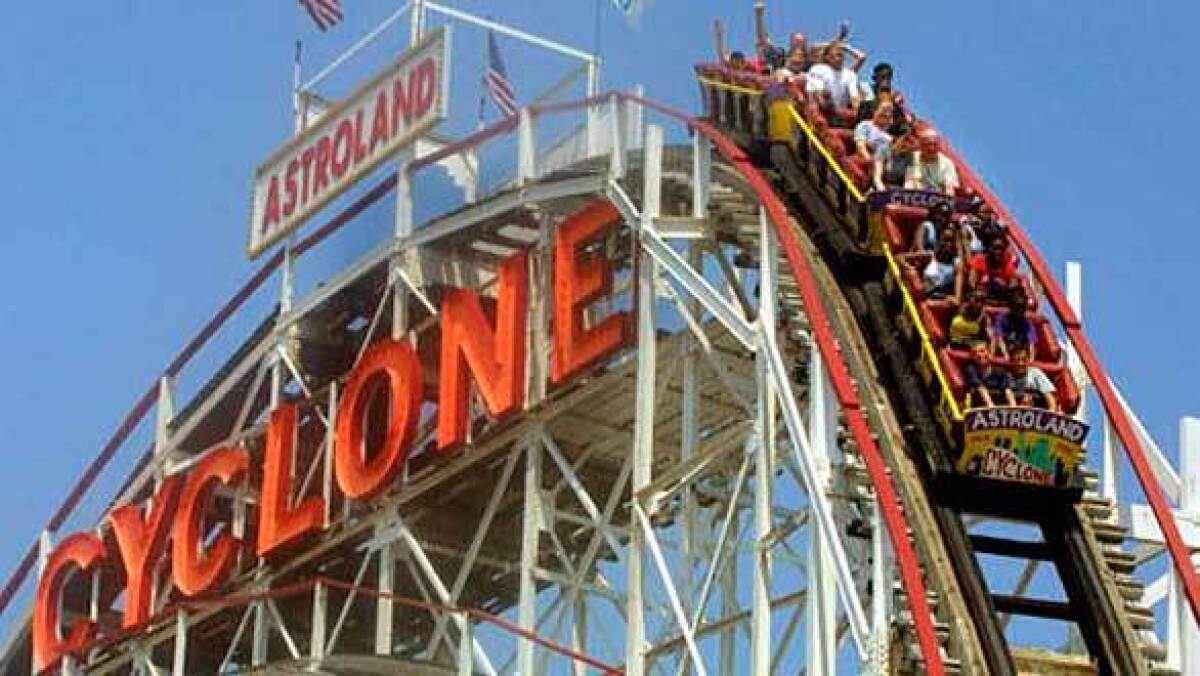Taking a nostalgic ride on the worldâs oldest roller coasters

Reporting from Lakemont Park in Altoona, Pa.--
My current travels across the great American roller-coaster belt will put me aboard five of the oldest operating coasters in the world, including the very oldest at little Lakemont Park here in Altoona.
Photos: View the 21 oldest roller coasters in the world
I found the rough, rickety and rundown Leap-the-Dips at Lakemont Park to be the perfect throwback to the golden age of coasters, when thrills were raw and wild rather than neutered by lawyers and lawmakers. The 109-year-old ride crystalized everything I was searching for in my road trip across the coaster belt: history, tradition, rarity, excitement and fun.
Like a temperamental old codger, Leap-the-Dips runs slower on humid days and a bit faster after a light rain. Ride operators occasionally have to hop in the back seat to ensure that the single car has enough weight to make it back to the station. The track visibly sways like a suspension bridge as the train swoops through the dips.
Beyond its age, what makes Leap-the-Dips unique are the things the train lacks: seat belts and any mechanism to keep the car attached to the track. That means the train literally leaves the track during the leaps and thuds back down on the dips. Sadly, Leap-the-Dips often sits idle for long stretches with visitors seemingly unimpressed by its historic heritage.
I would have never guessed that compiling a list of the worldâs oldest roller coasters would be so controversial. It turns out that nearly every one the 20 rides in our list comes with some sort of qualifier that might be considered a disqualifier, according to the Roller Coaster Database.
Some have been closed and left for dead only to be saved from the wrecking ball. In a number of cases, opening dates are in dispute. Others have been altered or updated in ways that stripped them of their classic qualifications. A few have been moved, extended or even destroyed, only to be completely rebuilt.
On the flip side, several of the coasters have been named national historic landmarks, and nearly half have been designated classics by American Coaster Enthusiasts.
Most of the coasters on my list were built in the 1920s during the âGolden Age of Roller Coasters,â when nearly 2,000 of the gravity ride attractions debuted. The worldâs first successful commercial roller coaster, the Gravity Switchback Railway, opened in 1884 at New Yorkâs famous Coney Island.
A handful of the classic rides on my list were designed by John A. Miller, an inventor known as the âThomas Edison of the roller coaster.â A similar number were built by Philadelphia Toboggan Co., the worldâs oldest roller coaster company. Almost all the coasters on the list are wooden, one is world famous, some are the last of their kind and a few are so far off the beaten path that you need a compass to find them.
Many of the worldâs oldest coasters share a kinship and bear similar names. There are two Jack Rabbits, two Railways, two with Thunder in the name and three simply called Roller Coaster. There are also two Giant Dippers, a Big Dipper and a Leap- the-Dips. A number of the coasters have been renamed multiple times, with a few restored to their original monikers.
Although many of the details remain open for debate, one thing is certain: All these roller coasters are survivors.
Leap-the-Dips - Built in 1902 at Lakemont Park in Altoona, Pa., the figure-eight wooden coaster was closed in 1986 and saved from demolition before reopening in 1999. American Coaster Enthusiasts has designated Leap-the-Dips a âCoaster Classic,â meaning the ride features single-position lap bars, no seat dividers, no headrests and allows riders to choose any seat. Leap-the-Dips features a side- friction design that lacks an extra set of wheels under the track to prevent the individual cars from becoming airborne.
Scenic Railway - Built in 1912 at Luna Park in Melbourne, Australia, the American Coaster Enthusiasts classic is the oldest continually operating coaster in the world. The wooden coaster features a brakeman who stands in the middle of the train.
Rutschebanen - Built in 1914 for the Baltic Fair, the wooden coaster was moved to Tivoli Gardens in Copenhagen in 1915. Designated a classic by American Coaster Enthusiasts, Rutschebanen features a side-friction design and employs an onboard brakeman. Rutschebanen is Dansk for âroller coaster.â
Wild One - Built in 1917 as the Giant Coaster at Paragon Park in Hull, Mass., the out-and-back wooden coaster was partially destroyed by fire twice. A pair of bunny hops and a 450-degree spiral helix finale were left out when the coaster was rebuilt after the second fire. The coaster was moved to Six Flags America in Upper Marlboro, Md., in 1986 and restored to its original condition.
Jack Rabbit - Built in 1920 at Seabreeze Park in Rochester, N.Y., the wooden out-and-back terrain coaster, designed by John A. Miller with a distinctive tunnel element, was rebuilt after a 1923 fire destroyed much of the ride.
Jack Rabbit - Built in 1920 at Kennywood in West Mifflin, Pa., the $50,000 wooden terrain coaster, designed by John A. Miller with a distinctive double-dip element and unconventional midcourse lift hill, has been designated an American Coaster Enthusiasts classic.
Roller Coaster - Built in 1921 at Lagoon Park inFarmington, Utah, the double out-and-back terrain wooden coaster, designed by John A. Miller and built by Philadelphia Toboggan Co., was damaged by fire in 1953 and rebuilt. Locals refer to the generically named ride as the âWhite Roller Coaster.â
Hullamvasut - Built in 1922 at Vidampark in Budapest, Hungary, the scenic railway-style wooden coaster didnât open to the public until 1926. The American Coaster Enthusiasts classic features a brakeman and a long four-minute, 30-second ride over 3,215 feet of track. Hullam means âwaveâ and vasut ârailwayâ in Hungarian.
Big Dipper - Built in 1923 at Blackpool Pleasure Beach in England, the out-and-back wooden coaster, designed by John A. Miller and built by Philadelphia Toboggan Co.,was extended to 3,300 feet in 1936.
Thunderhawk - Built in 1923 at Dorney Park in Allentown, Pa., the Thunderhawk out-and-back wooden coaster originally featured an out-and-back design but was modified to a figure eight in 1930. It was known simply as the Coaster until 1988.
Thunderbolt - Built in 1924 at Kennywood in West Mifflin, Pa., the twister-style wooden terrain coaster, designed by John A. Miller. was known as Pippin until 1968, when the American Coaster Enthusiasts classic was expanded using parts from the original ride and renamed Thunderbolt.
Giant Dipper - Built in 1924 at Santa Cruz Beach Boardwalk in , the $50,000 double out-and-back wooden coaster was added in 1987 to the rolls of the National Registry of Historic Places. Fredrick Church designed both Giant Dippers in California (the other is at Belmont Park in San Diego) as well as the Dragon Coaster at Playland Park in New York.
Giant Dipper - Built in 1925 at Belmont Park in San Diego, the $50,000 twister-style seaside wooden coaster, originally christened the Giant Dipper, was known simply as Roller Coaster from the 1950s to the 1970s. After briefly going by the name Earthquake, the coaster sat derelict from 1976 to 1990 before reopening as the Giant Dipper.
Wildcat - Built in 1927 at Lake Compounce in Bristol, Conn., the Philadelphia Toboggan Co. twister-style wooden coaster was completely rebuilt in 1986 following the original design. Magnetic brakes were added to the trains in 2007.
Racer - Built in 1927 at Kennywood in West Mifflin, Pa., the $75,000 racing wooden coaster designed by John A. Miller features an ingeniously crafted continuous-track layout that departs on one side of the station and returns on the other.
Cyclone - Built in 1927 at Coney Islandâs Astroland in Brooklyn, N.Y., the $175,000 hybrid coaster with a wooden track on a steel structure was condemned and nearly destroyed in the early 1970s until a campaign saved the ride. One of the most famous roller coasters in the world, the American Coaster Enthusiasts classic was added in 1991 to the rolls of the National Registry of Historic Places. The rideâs legendary layout became known as the Coney Island Cyclone design, which was replicated at amusement parks around the world.
Kiddy Coaster - Built in 1927 at Playland Park in Rye, N.Y., the American Coaster Enthusiasts classic wooden coaster was constructed for a mere $2,537 but didnât open until 1928.
Legend - Iowaâs Arnolds Park claims an official opening date of 1927 for the out-and-back wooden coaster, which contradicts newspaper accounts of a 1930 debut. Operating through the years as Speed Hound and Giant Dips, the ride was known for decades as the Giant Coaster until becoming Legend in 1996. The John A. Miller-designed ride was rebuilt after being severely damaged by a storm in 1968. Preservationists helped save the ride after the park closed briefly in the 1980s.
Montana Suiza - Built in 1928 at Monte Igueldo Park in San Sebastian, Spain, the scenic railway-style steel coaster with a side-friction design features an onboard brakeman.
Dragon Coaster - Built in 1929 at Playland Park in Rye, N.Y., the V-shaped out-and-back wooden coaster with the distinctive dragonâs mouth tunnel entrance served as the location for Mariah Careyâs 1995 âFantasyâ music video. The original two-bench articulated cars were replaced in 1988.
Roller Coaster - Built for the 1929 Colonial Exhibition in Paris, the American Coaster Enthusiasts classic wooden coaster was moved in 1932 to Great Yarmouth Pleasure Beach in England. The scenic railway-style ride features a mountainous landscape and employs an onboard brakeman to control the speed of the train.
More to Read
Sign up for The Wild
Weâll help you find the best places to hike, bike and run, as well as the perfect silent spots for meditation and yoga.
You may occasionally receive promotional content from the Los Angeles Times.







